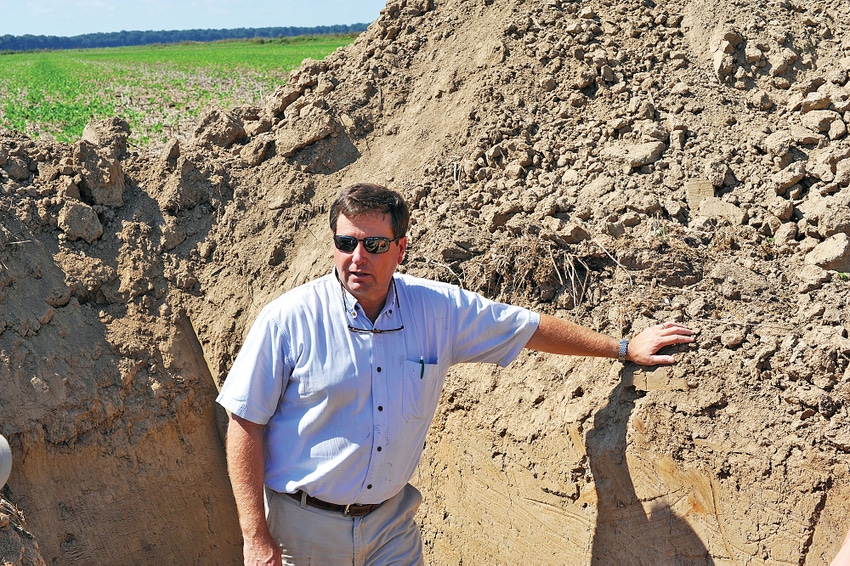October 26, 2014

Planting a winter cover crop has meant healthier soils with less compaction, decreased weed pressure and better internal drainage for one Mississippi farmer.
“We are trying to determine what the monetary benefit is for a cover crop system,” says Yazoo City, Miss., soybean and corn producer Rob Coker. “There is a return. What we are doing now is trying to quantify that return.”
Coker adopted a no-till production system six years ago, and three years ago he added a cover crop to the mix. In past years, he has used a combination of tillage radishes and a cereal rye mix for his winter plantings, but this year he’s trying a new cover crop combination made up of black oats, Mihi Persian clover, and tillage radishes. The tillage radishes, which produce longer tubers and a long tap root, appear to work well to reduce soil compaction and create routes for water and nutrients to penetrate deeper into the soil structure.
According to Rachel Stout Evans, a NRCS soil scientist based in Metcalfe, Miss., planting a winter cover crop helps to increase the macro pores in soil, and the larger pore space allows for more oxygen, water, and roots to move through the soil. “The first 6 inches of soil may be relatively loose due to tillage and seed planting, but below that often lies a compacted layer, which can act as a hard barrier that neither roots nor water can penetrate easily. Increasing the number of macro pores helps loosen the soil and aids in water movement,” says Stout Evans.
Coker says, “The cover crop essentially accomplishes the same task as a subsoiler, with an important, added benefit. With a cover crop, you have a channel in the soil held open with a root, and the soil doesn’t seal back in the spring like a subsoiling does.”
In many Delta crop fields, soil compaction allows roots to reach depths of only 4 to 6 inches before those roots begin running laterally. “A lot of rooting zones are much more shallow than is ideal. Water is not properly infiltrating the soil because the compacted soil layer is creating what is essentially a shallow pot that fills up quickly and then overflows. The compacted zone will not allow the water to get through,” she says.
“With more macro soil pores open and the compacted layer gone, the soil can hold or store more water in its entire profile,” Stout Evans says. “Those micro pores in tight soils will hold water but won’t give the water up easily to plant roots.”
When that soil compaction is relieved, however, roots can reach down 40 inches or more. On a recent visit to one of Coker’s fields, Stout Evans found a dead, brown root at a depth of 44 inches and a living white root, which appeared to be a soybean root, at a soil depth of 38 inches. “Grass is a healer. A cover crop with a grass like cereal rye is going to get those roots down quickly,” she says.
Coker is hoping that getting a corn root system with more roots in the 6 to 12 inches deep zone will provide increased nutrient availability and better water penetration. “That should mean higher yields with less stress and less supplemental water needed,” he says. “We’ve already noticed an improvement in internal drainage, as evidenced by a reduction in ponding areas and a decrease in hot spots.”
In addition to the soil benefits provided by a cover cropping system, Coker says the winter ground cover seems to be decreasing weed pressure, increasing and stabilizing yield, and boosting fertility.
“I’m seeing a drastic decrease in weed pressure,” he says. “Our biggest reduction has been in pigweed, although we have also seen a decrease in Johnson grass, and rye grass pressure. The competing winter vegetation has reduced weed populations, which has allowed us to reduce herbicide sprays.”
Stout Evans says producers who adopt a cover cropping system should also expect a fertility boost over time because a less-compacted soil will allow for better root growth. “The roots of the cover crop will capture nitrogen left over from the cash crop, and when the cover crop decomposes, that nitrogen is then released back to the cash crop in the spring and summer.
“The presence of earthworms tells us that you also gain organic matter and increase biotic activity with this cover crop system,” she adds.
“This is not a quick fix,” says Coker. “It is a long-term commitment, and it can be difficult to stick with because it takes six to 10 years to document the results. After three years, though, we were already seeing an increase in organic matter.”
He credits the technical assistance he has received from Delta F.A.R.M. (Farmers Advocating Resource Management) for the benefits he has realized through the utilization of a cover crop system. “This system is working,” Coker says. “Our next goal is to reduce tillage on fields containing irrigation furrows through the use of cover crop plantings.”
The Stoneville, Miss.-based Delta F.A.R.M. was formed in 1998. Its primary objective is providing landowners and farm operators with the technical assistance needed to address environmental concerns without reducing profitability.
For information about how Delta F.A.R.M. can help you, call (662) 686-3370 or go to www.deltafarm.org.
You May Also Like




